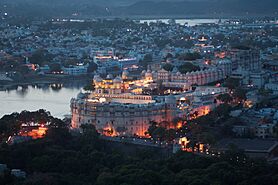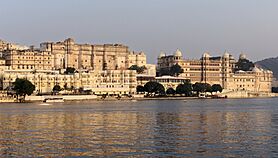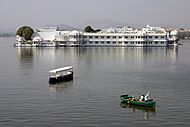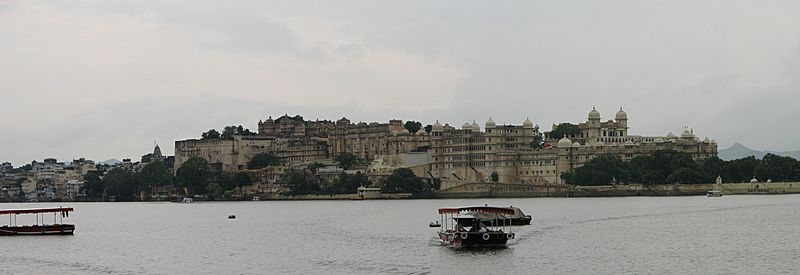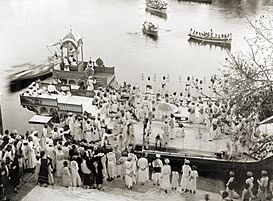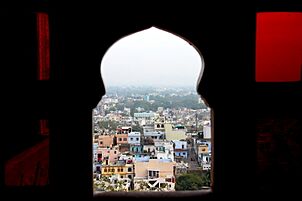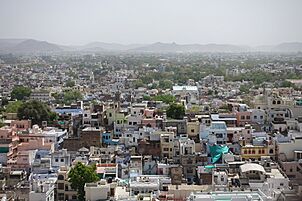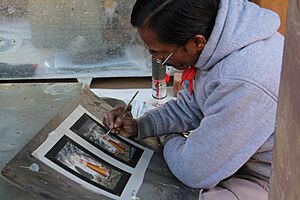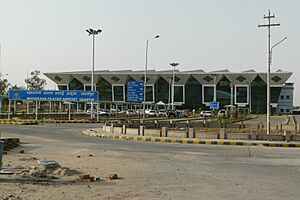Udaipur facts for kids
Quick facts for kids
Udaipur
|
|
|---|---|
|
Evening view of the city
City Palace complex
Jag Mandir
Monsoon Palace
Jagdish Temple
Lake Palace in Pichola Lake
Udaipur landscape
|
|
| Nickname(s):
The White City
|
|
| Country | |
| State | Rajasthan |
| District | Udaipur |
| Established | 1559 |
| Founded by | Rana Udai Singh II |
| Named for | Rana Udai Singh II |
| Government | |
| • Type | Municipal Corporation |
| • Body | Udaipur Municipal Corporation |
| Area | |
| • Metropolis | 132 km2 (51 sq mi) |
| Elevation | 423 m (1,388 ft) |
| Population
(2024)
|
|
| • Metropolis | 751,100 |
| • Metro | 1,374,531 |
| Languages | |
| • Official | Hindi |
| • Additional | English |
| • Regional | Rajasthani, Mewari |
| Time zone | UTC+5:30 (IST) |
| PIN |
313001- 313024
|
| Telephone code | +91-294 / 0294 |
| Vehicle registration | RJ-27 RJ-58 (Salumber) |
| Climate | BSh |
Udaipur is a beautiful city in the Rajasthan state of India. It is often called the City of Lakes because it has many large artificial lakes. It is also known as the White City because of its many white marble palaces and buildings. Udaipur was founded in 1559 by Udai Singh II, a ruler from the Sisodia family. He made it the new capital of the kingdom of Mewar.
The city is in the southern part of Rajasthan, close to the Gujarat border. It is surrounded by the Aravali Range, a mountain chain that separates it from the Thar Desert. Udaipur is a popular place for tourists. People love its history, culture, and amazing palaces from the Rajput era. It is also known for its museums, gardens, and old temples.
Contents
Discovering Udaipur's Past
Udaipur has a long and interesting history. It was once the capital of the Mewar kingdom.
Early Settlements in Udaipur
Long ago, around 2000 BCE, people lived near the Ahar River in this area. Two main groups lived here: the Bhil tribes, who were the original people, and the Rajputs, who came later and stayed for many centuries.
How Udaipur City Was Founded

Udaipur was started in 1559 by Maharana Udai Singh II. He chose this spot in the fertile Girwa Valley. It became the new capital of the Mewar kingdom. Before this, the capital was Chittorgarh, but it was often attacked.
Rana Udai Singh II wanted a safer place. He found a good spot near Lake Pichola while hunting. A story says a wise hermit blessed the king and told him to build a palace there, promising it would be safe. So, Udai Singh II built his home there.
In 1567, the Mughal Emperor Akbar took over Chittor. To protect Udaipur, Rana Udai Singh built a six-kilometer-long city wall with seven gates. This walled area is still called the old city today. Later, in 1615, Mewar became a princely state under British rule.
Exploring Udaipur's Geography
Udaipur is known for its beautiful natural setting, especially its lakes and hills.
Unique Geological Sites
Udaipur has some special geological spots. The Jharmar Kotra Stromatolite Fossil Park has very old fossils. Also, the Gossan in Rajpura-Dariba Mineralised belt has unique rock formations. These places are protected as National Geological Monuments. They help people learn about Earth's history.
Udaipur's Landscape and Lakes
Udaipur is located at an elevation of about 598 meters (1,962 feet) above sea level. It covers an area of 64 square kilometers (25 square miles). The city is in the southern part of Rajasthan, close to the border with Gujarat.
Udaipur sits on the southern side of the Aravalli Range. The northern part of the district has high plateaus. The eastern part has fertile plains, while the south is rocky with dense forests.
The city's lakes are all connected. They help refill groundwater, provide water for drinking and farming, and support tourism. The main lakes in the city are Lake Pichola, Fateh Sagar Lake, Swaroop Sagar Lake, Rang Sagar, Kumharia Talab, and Goverdhan Sagar. Downstream, there is also Udaisagar Lake.
Understanding Udaipur's Climate
Udaipur has a hot, semi-dry climate. There are three main seasons: summer, monsoon, and winter. Summers are from mid-March to June, with temperatures reaching up to 44°C (111°F).
Monsoons arrive in July, bringing rain and making the city green and beautiful. Winters are from October to March. Days are pleasant and sunny, and nights are cool, with temperatures from 5°C (41°F) to 30°C (86°F). The best time to visit Udaipur is during the monsoon and winter months, from mid-September to early April.
People and Languages of Udaipur
Udaipur is a growing city with a diverse population.
Population Growth and Literacy
In 2011, Udaipur city had a population of 451,100 people. Including nearby areas, the population was 474,531. The city's population has been growing because of its pleasant weather and attractions.
Udaipur has a high literacy rate of 90.43 percent. This means most people in the city can read and write. The male literacy rate is 95.41 percent, and the female literacy rate is 85.08 percent.
Languages Spoken in Udaipur
Hindi and Mewari are the main languages spoken in Udaipur. Other languages used include Marwari, Wagdi, Urdu, and Gujarati.
Religions in Udaipur
Hinduism is the main religion in Udaipur, followed by 72.9% of the people. Muslims make up 15.6% of the population. Udaipur also has a large Jain community, making up almost 10% of the population.
Udaipur's Economy and Industries
Udaipur has a varied economy, with tourism being a major part.
Handicrafts and Local Art
Udaipur is famous for its handicrafts. These include beautiful paintings, marble items, silver art, and terracotta. The Shilpgram is a special place where local artists create and sell their handmade products. Craft markets are held there to support these traditional arts.
The Importance of Tourism
Udaipur is a very popular place for tourists, both from India and other countries. Over 1.4 million tourists visited in 2016. The city has many luxury hotels and resorts, like The Oberoi Udaivilas and The Taj Lake Palace, which are known worldwide. Tourism greatly helps Udaipur's economy.
Mining and Mineral Industries
Udaipur district is rich in minerals like copper, lead, zinc, and silver. Industrial minerals such as phosphate, asbestos, and marble are also found here. Marble is mined, processed, and sent all over the world from Udaipur. This industry provides many jobs. Hindustan Zinc, one of the world's largest zinc producers, is also located here.
Electronics and Manufacturing
Udaipur also has companies that design and make electronic instruments, control panels, and LED lamps. These businesses employ over 6,000 people. Secure Meter Limited, a major meter manufacturer, is one of these companies.
Agriculture in Udaipur
Agriculture is an important part of Udaipur's economy. Farmers grow maize and jowar in the summer (Kharif season) and wheat and mustard in the winter (Rabi season). Other crops include pulses, groundnuts, and vegetables like brinjals and tomatoes. The Maharana Pratap University of Agriculture and Technology helps farmers learn new and better ways to grow crops.
Top Tourist Attractions in Udaipur
Udaipur is filled with amazing places to visit, from grand palaces to peaceful gardens.
| Picture | Attraction | Period | Description |
|---|---|---|---|
 |
City Palace, Udaipur | 1559 | This huge palace complex stands on the east bank of Lake Pichola. It was built over many years starting in 1559. You enter through the Tripolia gate. The palace now has a museum with old items, paintings, and furniture from royal times. |
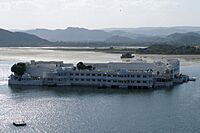 |
Lake Palace | 1743–1746 | Located on an island in Lake Pichola, this palace was built as a summer retreat for royalty. Made of white marble, it is now a luxurious 5-star hotel run by "Taj Hotels Resorts and Palaces". |
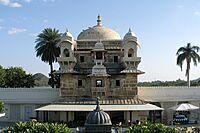 |
Jag Mandir | 1551–1652 | Jag Mandir is another palace on an island in Lake Pichola. It's also called the "Lake Garden Palace." Three Maharanas of Mewar helped build it. The royal family used it as a summer and pleasure palace. |
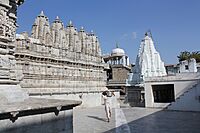 |
Kesariyaji Temple | 9th century | This temple is dedicated to Lord Rishabh dev, the first Jain Tirthankara. Its fifty-two tall spires can be seen from far away. The main idol is a black stone statue of Tirthankara Rishabha. |
 |
Monsoon Palace and Biological Park | - | Also known as Sajjan Garh Palace, it was built to watch monsoon clouds and served as a summer home for the Maharanas. It sits on a hill, offering great views of the city's lakes and palaces. Below it, a biological park opened in 2004-2005, with many animals and birds. |
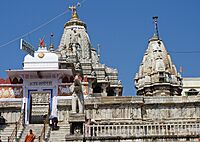 |
Jagdish Temple | 1651 | The Jagdish Temple is a large Hindu temple in the center of Udaipur. Maharana Jagat Singh I built it. It's a popular tourist spot and a great example of Māru-Gurjara architecture. |
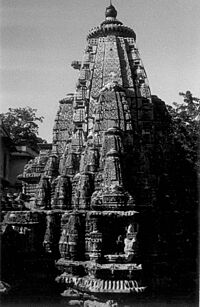 |
Eklingji | 8th century | The Eklingji Temple, dedicated to Lord Shiva, is 25 kilometers from Udaipur. It's a very important Hindu pilgrimage site. The temple is grand and artistic, with a 50-foot-tall tower. It has a five-faced Shiva Lingam and a large campus with 72 holy sites. |
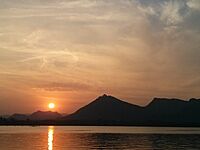 |
Fateh Sagar Lake | 1678 | Fateh Sagar is an artificial lake in the north-west of Udaipur. Maharana Jai Singh first built it, and Maharana Fateh Singh later rebuilt and expanded it. It also has an aquarium called 'Under the Sun'. |
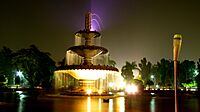 |
Sukhadia Circle | 1968 | Sukhadia Circle is a large roundabout and recreation area in the city's northern part. In its center is a pond with a 21-foot-high marble fountain, shaped like a wheat-ear, symbolizing prosperity. |
 |
Saheliyon-ki-Bari | 1710–1734 | Saheliyon-ki-Bari is a beautiful garden in the northern part of the city. It has fountains, kiosks, a lotus pond, and marble elephants. It was made for 48 young women who came with a princess as part of her dowry. |
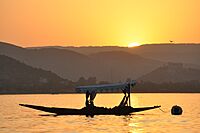 |
Lake Pichola | 1362 | Lake Pichola is a large artificial freshwater lake in Udaipur. Over centuries, palaces, marble temples, and bathing steps (ghats) have been built around its shores and on its islands. |
 |
Moti Magri | - | Moti Magri, or Pearl Hill, is a memorial to the Rajput hero Maharana Pratap. On top of this small hill is a bronze statue of Maharana Pratap riding his horse, Chetak. |
| Neemach Mata Temple | - | Neemach Mata Temple is on a hill near Fateh Sagar Lake. It's 900 meters up, offering a full view of Udaipur. A new ropeway, opened in January 2024, makes it easy and scenic to reach the temple. | |
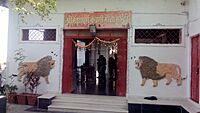 |
Karni Mata, Udaipur | - | Karni Mata Temple is near Doodh Talai, close to Lake Pichola. A ropeway takes visitors up the hill to the temple. From there, you can see Lake Pichola, Jag Mandir, Doodh Talai, and the entire city. |
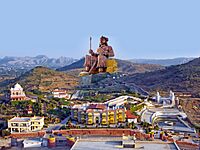 |
Pratap Gaurav Kendra | - | Pratap Gaurav Kendra Rashtriya Tirtha is on Tiger Hill. It teaches about Maharana Pratap and the area's history using modern technology. |
 |
Gulab Bagh and Zoo | - | Gulab Bagh is Udaipur's largest garden, right in the city center. It has many different plants, ponds, a library, a toy train, a zoo, and temples. |
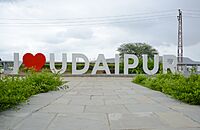 |
Pratap Park | 2016 | Pratap Park is a garden near Lake Pichola. It has an outdoor gym and is popular for its "I LOVE UDAIPUR" sign, with the lake and City Palace in the background. |
| Udaisagar Lake | 1565 | Udai Sagar Lake is one of Udaipur's five main lakes. It's about 13 kilometers east of the city. Maharana Udai Singh started building it in 1559 by damming the Berach River to provide water for his kingdom. The lake is 4 km long, 2.5 km wide, and about 9 meters deep. | |
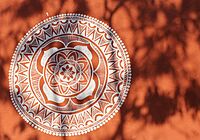 |
Shilpgram, Udaipur | - | Shilpgram is a crafts village 3 km west of Lake Fateh Sagar. It shows traditional houses from different Indian states and hosts demonstrations by musicians, dancers, and artisans. |
Udaipur's Rich Culture
Udaipur has a vibrant culture with old traditions, folk dances, and music.
Traditional Dances and Music
Folk dance and music are very important to Udaipur's culture. Energetic dances like Bhavai, Ghoomar, Kachchhi Ghodi, Kalbeliya, and Terahtaali add to the city's cultural richness.
- Ghoomar dance is performed by women in circles during special events.
- Kalbelia is a graceful dance by the Kalbelia snake charmers' community. Dancers wear long, black skirts with silver ribbons.
- Bhavai dance involves women balancing many brass pitchers on their heads while spinning and dancing on glass or sword edges.
- Kachchhi Ghodi dance features men on dummy horses, holding swords, and dancing to drums and fifes.
The music often uses instruments like the morchang, naad, tanpura, and sarangi.
Miniature Paintings and Art
Miniature paintings are a famous art form from Rajasthan. These detailed paintings are often found on walls or on cloth. Pichvais are paintings made on cloth, and phad paintings are made on cloth scrolls in a folk style. People in Udaipur often decorate their homes with wall paintings for weddings.
The Bharatiya Lok Kala Mandal is a cultural center in Udaipur. It has a museum that shows off Rajasthani culture. You can see old dresses, tribal jewelry, turbans, dolls, masks, musical instruments, and puppets. The institute also hosts cultural events like folk songs, dances, theater, and puppet shows.
Festivals and Celebrations
Udaipur celebrates many colorful festivals throughout the year.
Gangaur Festival
Gangaur is a very important Hindu festival in Rajasthan. "Gan" means Shiva, and "Gauri" means Hindu Goddess Parvati, Shiva's wife. Gangaur celebrates their marriage and is a symbol of happy married life.
It is celebrated in March or April, marking the start of spring. Women worship clay idols of Gan and Gauri. Girls pray for a good husband, and married women pray for their husbands' health and long life. Women also decorate their hands with henna.
A traditional procession for Gangaur starts from the City Palace. It includes old palanquins, chariots, and folk artists. The idols of Gan and Gauri are then immersed in Lake Pichola from Gangaur Ghat.
Shilpgram Utsav
Shilpgram hosts a 10-day festival called Shilpgram Utsav. It showcases traditional houses and crafts from Rajasthan, Gujarat, Goa, and Maharashtra. Visitors can see musicians, dancers, and artisans at work. The festival aims to teach younger generations about rural life and crafts through workshops on arts, crafts, theater, and music.
Hariyali Amavasya
Hariyali Amavasya (the new moon day of the Sawan month) marks the beginning of the monsoon season and new greenery. It happens three days before Hartalika Teej. People worship Lord Shiva for good rains and a successful farming season. Fairs and festivals are held in different parts of the city.
Jagannath Rath Yatra
Udaipur hosts the third largest Ratha-Yatra (chariot festival) in India. It takes place on June 21st each year. During this festival, the Hindu gods Jagannath (Krishna), Balabhadra (Balarama), and their sister Subhadra are carried through the streets in beautifully decorated wooden chariots. Many Hindus believe that touching the chariot or pulling its ropes brings good fortune.
Jal-Jhulni Ekadashi
Jal-Jhulni Ekadashi is celebrated on the 11th day of each moon phase in the Hindu calendar. Like other festivals, it is celebrated with great excitement and joy.
Getting Around Udaipur
Udaipur is well-connected to major Indian cities by air, rail, and road.
Air Travel
Maharana Pratap Airport is a small airport about 20 kilometers (12 miles) from Udaipur. It has daily flights connecting Udaipur to cities like Jaipur, Mumbai, Delhi, and Bengaluru. Airlines such as Air India, Vistara, IndiGo, and Spice Jet operate here.
Train Travel
Udaipur has two main railway stations: Udaipur City railway station and Rana Pratap Nagar railway station. You can take direct trains from Udaipur to many major cities in Rajasthan and other parts of India, including Delhi, Mumbai, and Kolkata. Luxury trains like Palace on Wheels also stop in Udaipur.
Road Network
Udaipur is located on important national highways, including NH 76 and NH 8. It is about 700 kilometers (435 miles) from both Delhi and Mumbai. The roads are well-paved, making it easy to drive from nearby cities like Jaipur and Ahmedabad. The Udaipur City Bus Depot offers bus services to many destinations in Rajasthan and other states.
Local Transportation
Within the city, you can find unmetered taxis, private taxis, auto rickshaws, and city buses. Since 2015, ride-sharing services like Uber and Ola are also available.
Fun Sports in Udaipur
Udaipur offers various sports activities, including cricket, football, and chess.
Sports Stadiums and Facilities
Gandhi Ground is a main sports venue for events like athletics, basketball, and football. The Luv Kush Indoor Stadium is used for indoor sports like Badminton and Table Tennis. Maharana Bhupal Stadium hosts football and cricket matches. To encourage sports, the city built 'Khel Gaon' (Sports Village), or Maharana Pratap Khel Gaon, which supports 12 different sports.
A new Udaipur International Cricket Stadium is planned, with a capacity for 35,000 people.
Cricket and Chess
Udaipur has many cricket clubs and has produced state-level players. Some players from Udaipur have even played in the IPL.
Chess is also very popular in Udaipur. The city has over 120 international chess players. Udaipur often hosts international chess events, attracting many players from around the world.
Water Sports and Powerlifting
Udaipur's lakes are great for water sports. Jaisamand Lake, about 56 km (35 miles) from the city, offers various boating options. Kayaking and Canoeing camps are held at Fateh Sagar Lake. Udaipur also hosted the National Kayaking and Canoeing Championship in 2012.
The city has also hosted the Asian Powerlifting Championships in both 2012 and 2016.
Learning in Udaipur
Udaipur is becoming an important center for education.
Universities and Institutions
Udaipur is home to several universities. Major government universities include Mohan Lal Sukhadia University, Maharana Pratap University of Agriculture and Technology, and Rajiv Gandhi Tribal University. There are also private universities like Pacific University and Bhupal Nobles University. The Indian Institute of Management Udaipur, a top management school, was established here in 2011.
Media and Communication
Udaipur has various newspapers, radio stations, and TV channels.
Newspapers and Radio
Hindi daily newspapers in Udaipur include Rajasthan Patrika and Dainik Bhaskar. English newspapers like The Times of India are also available.
All India Radio broadcasts on both medium wave and FM (101.9 MHz). There are also four private local FM radio stations: Radio City FM (91.9 MHz), Big FM (92.7 MHz), My FM (94.3 MHz), and Radio Tadka (95 MHz).
Television Services
The public broadcaster Doordarshan provides a regional channel along with its main channels. The city is also upgrading to digital cable TV services.
Images for kids
See also
 In Spanish: Udaipur para niños
In Spanish: Udaipur para niños


